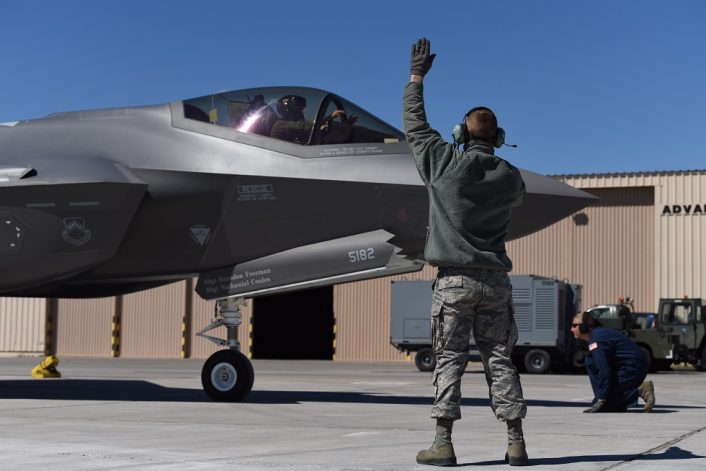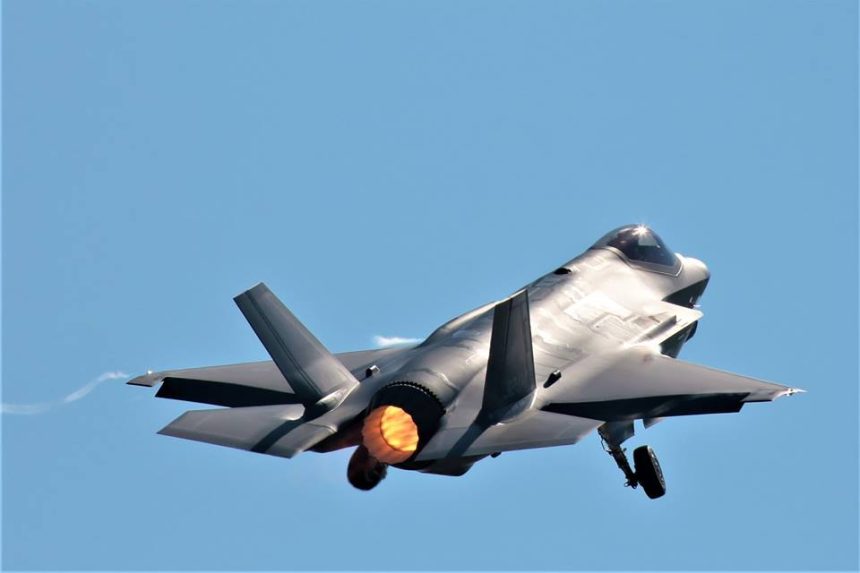ItAF aircrews with the 62nd FS were literally enthusiastic about their first Red Flag with the new 5th generation aircraft.
Red Flag 19-2 has come to an end at Nellis Air Force Base, Nevada, on Mar. 22, 2019. The latest iteration of the world’s most famous exercise was particularly interesting for several reasons: first of all, there was a significant variety of “exotic” assets, including the Royal Saudi Air Force brand new F-15SA, the Republic of Singapore Air Force F-15SG and the UAE Air Force F-16E Block 60 aircraft.
Second, RF 19-2 was the first Red Flag to see the attendance of a multinational squadron: the 62nd Fighter Squadron (FS) “Spikes” from Luke AFB, with IPs (Instructor Pilots) from the U.S., Italy and Norway.
Beloning to the 56th FW, the 62nd FS is one of the three dedicated F-35 training squadrons at Luke. The 62nd trains an international cadre of F-35 pilots from partner nations, including Norway and Italy. In fact, three Italian Air Force IPs with the 62nd FS took part in the RF 19-2 flying for the first time with the F-35 Lightning II 5th generation jet.
The integration between 4th and 5th generation aircraft was one of the leitmotifs of the exercise: considered that for the next 10-15 years 70% of NATO aircraft will be “legacy” ones, it is necessary to learn how to work together. That’s why Red Flags (or TLP courses, in Europe), aim at improving integration between platforms. “It is only by integrating the capabilities of the fourth and fifth generation aircraft that results both platforms can achieve can be maximized”, said Maj. Emanuele A. one of the ItAF IPs flying with 62nd FS in an official release.
Noteworthy, the F-35A Lightning II of the 62nd FS played many different roles during RF 19-2: the stealth aircraft were tasked with escorting coalition aircraft and protecting them from ground-to-air SAM threats during SEAD missions; at the same time, together with other dedicated assets, such as the F-15Cs, they defended the coalition aircraft from “enemy” planes, providing air superiority for the friendly packages. Furthermore, the F-35 played the “Battle Manager” role, sharing tactical information to other aircraft during DCA (Defensive Counter Air) missions.
Usually operating in flights of four aircraft, the F-35s acted as “force enablers”, neutralizing several threats: on average about seven SAM systems and five Red Air assets were “killed” during each mission, according to the Italian Air Force. Moreover, the five aircraft deployed to Nellis AFB were able to launch 100 percent of the planned missions: two four-ship missions, each day.
 One of the 62nd FS F-35 prepares to taxi at Nellis AFB, during RF 19-2. (Image credit: U.S. Air Force).
One of the 62nd FS F-35 prepares to taxi at Nellis AFB, during RF 19-2. (Image credit: U.S. Air Force).ItAF aircrews with the 62nd FS were literally enthusiastic about their first Red Flag with the new aircraft.
“Being at the controls of an F-35, a fifth-generation aircraft, has always been a dream. I imagined that the machine had unique capabilities in combat and I had the confirmation from the first flight […] but participating in the Red Flag, one of the best exercises in the world, confirmed it to me beyond all expectations” Maj. Alessandro P. said.
“The results we have achieved in these two weeks are almost unbelievable: the statistics do not need comments”.
The F-35 was the most effective asset in neutralizing SAM systems and absolutely essential in the timely sharing of all the specific information needed for the success of the mission.
“We knew we had an operational advantage, due to the 5th generation technology, but we didn’t expect such a high “kill” ratio: in the 16 OCA missions (Offensive Counter Air) we flew, we neutralized more than 100 SAM systems and never lost a plane,” commented Maj. Emanuele A.
“I was impressed by the capabilities demonstrated by the F-35 in a complex and realistic environment such as the Red Flag where there are real professionals who simulate the Red Air” added Maj. Giuseppe A. at the end of the exercise. “During our missions we were among the first to enter the area of operations, far beyond the enemy lines, and the last to leave it, thanks to both the great persistence and the peculiar Low-Observability characteristics of our 5th generation aircraft. We were able to identify, transmit and neutralize ground and air threats very quickly, protecting the coalition’s assets in highly risky circumstances: the superior capabilities of the F-35 were often decisive. […] During the exercise, we achieved a high level of interoperability that allowed us, as a coalition, to tackle missions with a very high level of threat and complexity in which the F-35 was certainly essential to achieve its objectives. ”
U.S. Air Force Maj. Gen. Peter Gersten, Commander of the Air Warfare Center, flew a 62nd FS F-35 during a Red Flag mission, in a formation consisting of two Italian pilots and a Norwegian pilot. At the end of the flight he declared: “It was an honor to fly with the Italian F-35 team of instructors during the Red Flag. Our network of alliances and partnerships is the backbone of global security, and exercises like the Red Flag help strengthen these relationships. Likewise, the F-35 program was designed to integrate strategic and allied partners so that we can better train ourselves to be ready to operate in real-world scenarios. It is essential that the technological tools we have available can be integrated to complete the mission we are called upon to perform in the best way, in the end it is about the aviators of our nations that work together and make a real difference. I am proud to have taken part in the mission and to personally observe the professionalism of this extraordinary team.”
Moreover, as underlined by Col. Igor Bruni, Commander of the RAMI (Rappresentanza Militare Italiana) based at Eglin (Florida) – the joint unit handling the training of all Italian military personnel, both of the Air Force and the Navy, designated to operate on the Italian F-35 aircraft – the Italian instructors with the 62nd FS have distinguished themselves during RF 19-2, being nomitated “Top Performer of the Mission”, either personally or as a member of an F-35 formation.
RF 19-2 was the second Red Flag in 2019. RF 19-1 also saw the participation of the F-35: as already reported, airmen of the 388th FW, brought their stealth aircraft to the world’s premiere simulated air war earlier this year. And were enthusiastic too about the results they were able to achieve.
Therefore, while criticism continues to surround the program (because of technical issues, cost, reliability, delays, missed promises etc.), pilots continue to voice their full satisfaction with the aircraft and the way it fights modern threats in complex exercises, like Red Flags.
And if you are among those who still believe that RFs are “useless”, “easy” or “fake” exercises crafted to serve someone’s agenda, I suggest you to read this past article written by a former combat pilot who went twice to Red Flag and said something interesting and unbiased about the role of the F-35.









